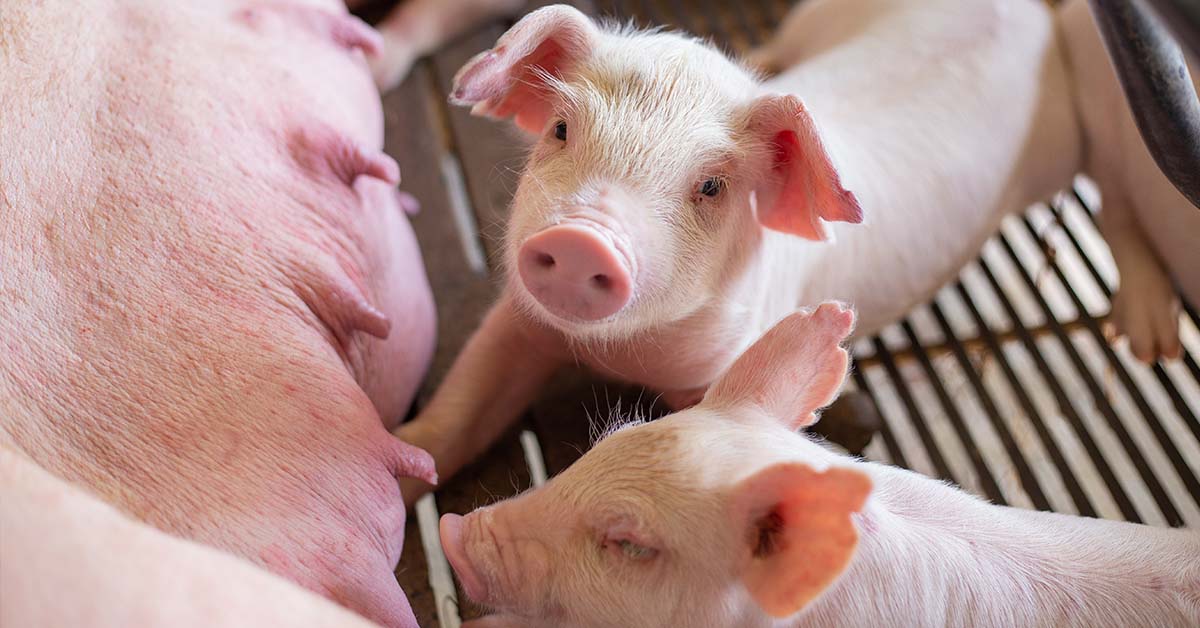Everything To Know About Weaning Piglets

One of the most critical times in a pig’s life is weaning. They are often moved to a new environment, given new roommates and transitioned from milk to solid feed for the first time. All of these changes at one time can be very stressful for a young pig.
It is estimated that a 1-pound heavier pig at the end of the nursery equates to an approximately 2 to 4 pounds heavier pig at market. Therefore, implementing proper management by forming a feeding plan that provides nursery diets at the right time, order, and balance is absolutely essential in order to help piglets stay healthy, ease the stress of weaning, and set your piglets up for success for the rest of their lives.
Tips for Feeding Your Piglets
During weaning, piglets new to eating on their own will have abrupt changes in feeding behaviors and daily schedule. During this time, it is essential to slow down, observe your piglets, and focus on details in order to help give them every chance they can to succeed. Before weaning your pigs, here are some tips to consider:
- When you move piglets to their new pen, make sure they know where their food and water is. Let the waterers drip for about 10 to 20 minutes the first few days so they know where water is. Sprinkle some feed near the feeders, preferably on a mat, and put pigs up to the feeder to make sure they see it, smell it and can easily find and associate the feeder with food. Invest in the time to do this for the first 3 to 5 days to help entice pigs to get up and eat.
- Providing the best quality food you can in this stage of their life is so important! Make sure the pigs have access to fresh and clean food and water at all times. We will elaborate on this further below.
- If you can, consider a creep feed. Presenting them with creep feed a few days while they are still with the sow may introduce those feeding behaviors they will need once weaned.
- If you see pigs struggling at first, try a gruel feeder, which is a simple feeder that can be set on the floor of the pen. Mix a hand full or two of feed with water to make it wet. You can assist the pigs in eating this or let them try it on their own. Sometimes, taking this extra step of wetting the food can help ease this transition of wet to dry food for young pigs that are having a hard time at first.
- Feed pelleted diets during the first one or two phases of your nursery budget in order to prevent sorting. This ensures pigs are receiving all of the necessary nutrients in the proper balance.
- Do not over stock the pens. This will help avoid feeder/water space competition. It is recommended to have 1.5 to 2 square feet of pen space per pig immediately post-weaning if there are 25 or fewer piglets in the pen. As they get older, this will expand to about 3 square feet per pig by the end of the nursery period (about 45-50 pounds bodyweight). Provide a feeder and water space for every 12 pigs in the pen.
- Pay close attention to the environment these pigs are in. Avoid drafts, if possible, while still ensuring ventilation is providing plenty of fresh air. Watching the pigs’ behavior can let you know if there might need to be adjustments in temperature. Piglets like to cuddle each other, but if they are completely huddling and laying on top of one another, they are probably cold. On the other hand, if they are spread out and not touching each other, they might be telling you they are too hot. In general, piglets are similar to humans and at first, as babies, they prefer the temperature to be around 82 to 85 degrees. After almost a week, it can be gradually dropped by half of a degree to one degree.
- Design your nursery all-in and all-out (AIAO). AIAO means weaning groups of pigs at the same time and keeping them together in the same room throughout the nursery period. Do not introduce new pigs into this space if at all possible. This limits co-mingling between groups, which prevents disease spread.
Because the pigs’ diets are so crucial during this time, here are some general things to look for and keep in mind when shopping for nursery feeds:
- Optimal protein sources, as not all sources are equal. Especially for the first few diets, look for good quality proteins (ex. milk proteins high in dietary lactose, like whey) in order to provide high quality, palatable and very digestible nutrients.
- Feeds that smell and taste good help attract pigs to the feeder and keep them coming back for more.
- Gut health-enhancing ingredients, like prebiotics/probiotics, can aid in building gut health back up faster after weaning, resulting in a more efficient transition time.
- Highly fortified with vitamins and minerals to ensure the piglets are provided the building blocks they need for ideal growth and performance.
At Kalmbach Feeds®, we understand every operation is different. Therefore, we offer many options so every pig owner can take these recommendations and implement them in a way that makes sense for their farm, while still providing all the needed nutrients at the right time for their piglets. Because the time of weaning is so critical, we want to ensure owners are given all of the tools and information to make the best decision for their herds. We have compiled an overall feed recommendation guide based on years of on-going research and first-hand observations on our website, which provides the product names, sequence, and budgets for Kalmbach’s designed and recommended Target Wean program of creep feeds, newly weaned piglet diets, and on through to grower diets (+25 pounds body weight).
